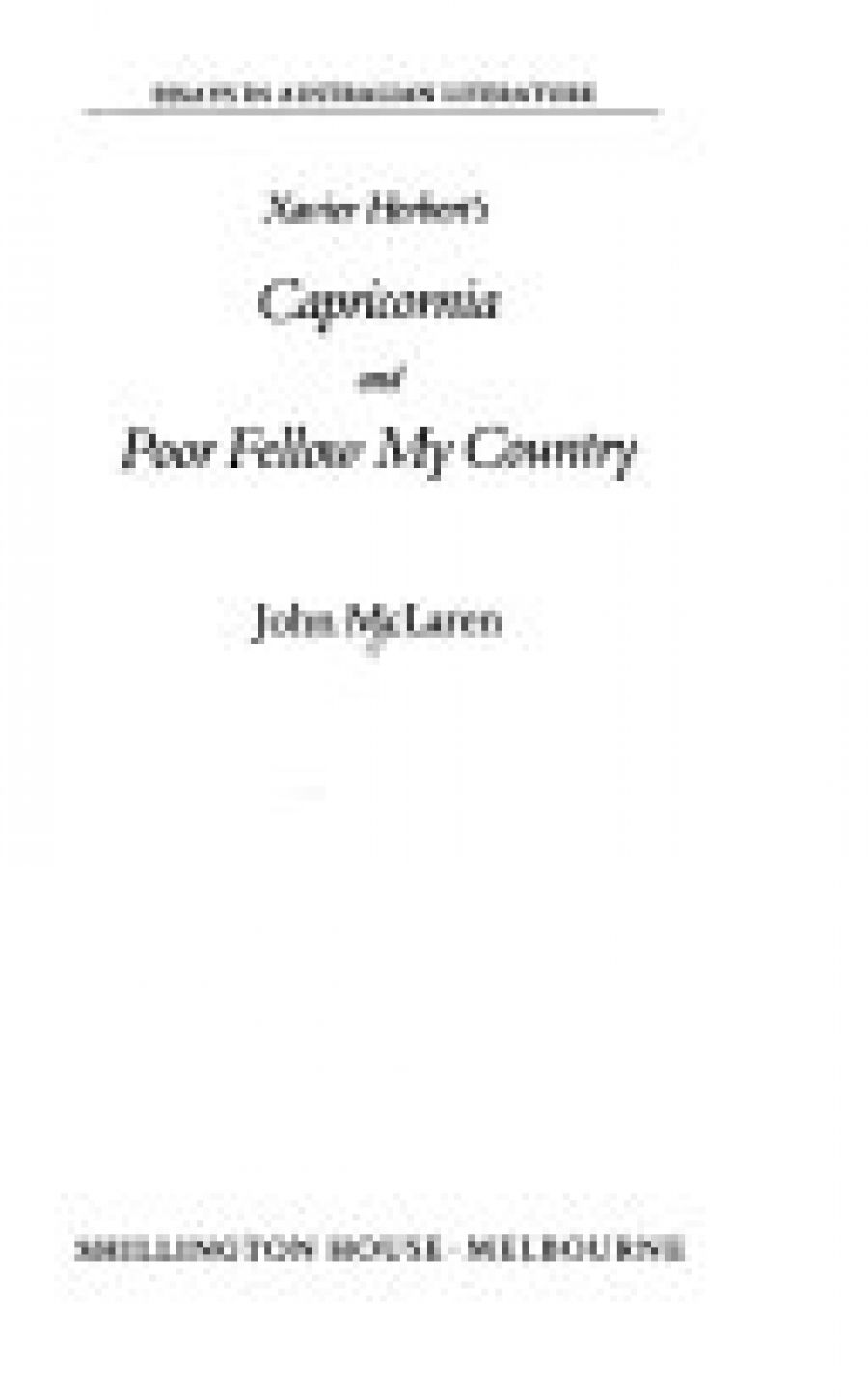
- Free Article: No
- Contents Category: Fiction
- Review Article: Yes
- Article Title: The Enigma of Hebert
- Online Only: No
- Custom Highlight Text: John McLaren’s contribution to the new series titled ‘Essays in Australian Literature’ is, as the editorial page proclaims, ‘the first extended study of the two major works by Xavier Herbert - his first novel, Capricornia, and his last, Poor Fellow My Country.
- Book 1 Title: Xavier Herbert’s Capricornia and Poor Fellow My Country
- Book 1 Biblio: Shillington House, $3.70 pb, 48 pp
- Book 1 Cover Small (400 x 600):

Herbert's writing has the enigmatic quality of the man. But his right both to live apart from society and yet maintain a valid role as a social critic is not generally criticised, whereas many critics refused to acknowledge that his writing could have imaginative vision as well as social relevance. One has only to consider the history of critical attitudes to Steinbeck’s The Grapes of Wrath, or Plomer’s Turbott Wolfe, or Capricornia for that matter, to realise that the novel of social purpose needs to be around some forty years or more before the critic is able to detach himself sufficiently from the controversial nature of its subject matter to consider whether it has any intrinsic aesthetic value. The fact that Herbert’s writing so obviously functions on more than one level of meaning has undoubtedly deterred many critics unwilling to face the implicit challenge to their assumptions about the nature of literature in particular, that the work should be both self-contained and self-sufficient’; or, that the inclusion of an imaginative element, necessarily subjective, will inevitably undermine the social ‘objective’. It is to McLaren's great credit that he has been prepared to meet this challenge, to re-examine his own critical assumptions, and it is because he has not shirked this responsibility that his conclusions, although one may not always agree with them entirely, are valuable.
Whereas the critical reception of Poor Fellow My Country has revolved around technical issues, such as the author’s intrusion into the narrative, McLaren more meaningfully concludes: ‘His involvement with his subject the people and their land —is his stimulus for his readers to do the same’. It is this ‘instrumental’ quality of Herbert's writing which offers the greatest challenge to our literary responses. ‘If we value the books’, so Herbert implies, ‘we must respond through actions rather than through mere appreciation’. In the first chapter of Poor Fellow My Country, where Herbert spells out the thesis of the whole novel, the exhortatory nature of his writing is most apparent, and McLaren perceptively notes that the rest of the novel could be described as a series of controlled experiments to demonstrate the validity of the thesis that the white man is his own worst enemy, alienating himself from the land by his actions. This is an important point, but one which is equally applicable to Capricornia.
The disintegration of the Yurra-cumbunga Tribe in Chapter One of that novel, and the death of Ned Krater, the archetypal invader, in Chapter Four, function as symbolic tableaux and frames of reference for the rest of the narrative. If there is a fault in McLaren’s study it is in his failing to observe several such opportunities to illuminate the links between the two novels. One could fruit-fully argue, for example, that not only Poor Fellow My Country challenges us to interpret it in ‘different and sometimes incompatible’ ways. The fault is partly caused by the structure of the essay, which to be fair, is presumably dictated to some extent by the series’ restriction on length. The Herbert essay is divided into three sections, the first dealing with Capricornia, the second with Poor Fellow My Country, and the third with critical issues’. The final section, although unfortunately brief, is particularly valuable because it allows the freedom for cross-referencing which is not possible in the other sections.
This essay does not simply give a digest of received opinion. McLaren has approached Herbert's work with the idea of function uppermost in mind, and relates that to form in order to show us precisely how each novel attempts to change the reader’s thinking about Australian society. He neither pre-supposes nor circumscribes the purpose of the novel. This in itself places McLaren in a position far superior to most of Herbert’s critics.


Comments powered by CComment